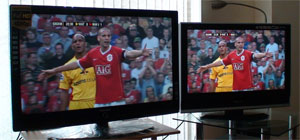
You’ve read Colin’s excellent article on motion compensated frame interpolation, here’s a real-life video of it in action. We pitted the Panasonic TX32LXD70 (top video) equipped with their 100Hz Motion Picture Pro technology against the Toshiba 32C3030D (bottom video). Click on the “Play” button to start (IE users may have to click twice):
Note: any scanning artifacts are caused by my camcorder and rendering software rather than the TVs themselves.